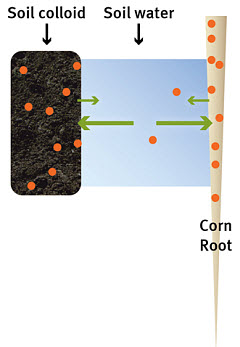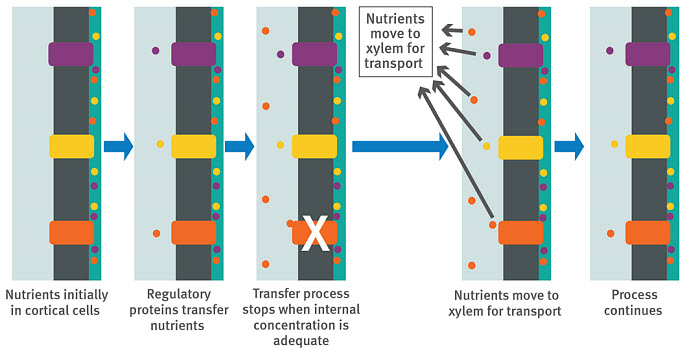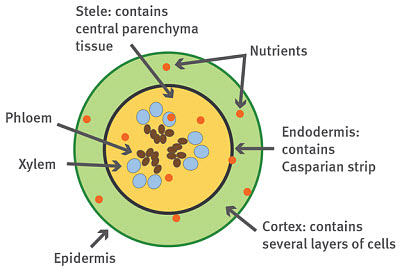Summary
- Healthy corn crop growth requires a variety of nutrients, 16 of which are absolutely essential for plant development.
- Regulation of nutrient uptake in variant texture, pH, and chemical properties of the soil is a physiological process that allows the corn plant to maintain a proper nutrient balance.
- Nutrient uptake from the soil is a seven-step process, requiring input from the plant with participating elements of the roots, energy input, and vascular tissues.
- Nutrient concentration of internal root cells regulates how much additional nutrient must be transported through the plasma membranes.
- Plant growth results because of the transportation of these nutrients from internal root cells to other portions of the plants via the xylem and phloem.
- Agronomic practices that best support this nutrient extraction process to obtain maximum grain yield include eliminating compaction, draining wet soils, monitoring for nutrient deficiency, and maintaining adequate water supply to the growing crop.
Introduction
Sixteen nutrients are essential for corn growth. Carbon and oxygen, the most abundant nutrients, are extracted from carbon dioxide and molecular oxygen, respectively, in the atmosphere. Hydrogen is extracted from degradation of water molecules during photosynthesis. As water molecules break down into hydrogen and oxygen, hydrogen is initially incorporated to make sugar. Oxygen is either incorporated for corn growth or released into the atmosphere as a by-product. Five of the six macronutrients, calcium, magnesium, nitrogen, phosphorus, and potassium, and the seven micronutrients, boron, chlorine, copper, iron, manganese, molybdenum, and zinc, are extracted from soil. The secondary macronutrient sulfur is extracted mostly from soil but may also be extracted from the atmosphere depending on the concentration of sulfur-containing compounds. Mature corn, no matter which hybrid is produced or in what soil type the hybrid is grown, contains a relatively consistent range of each of these 16 nutrients (Figure 1) (Latshaw and Miller, 1924).
Essential Elements for Crop Production
- Supplied by air and water: carbon, hydrogen, oxygen
- Primary macronutrients: nitrogen, phosphorous, potassium
- Secondary macronutrients: sulfur, calcium, magnesium
- Micronutrients: boron, chlorine, copper, iron, manganese, molybdenum, zinc

Figure 1. Nutrient content in a mature corn plant.
This consistency in nutrient concentration is an amazing feat when one considers the heterogeneity in soil physical and chemical properties in which corn plants grow. For any given soil, the nutrient concentration at one sample location may be up to a thousand times greater or less than the nutrient concentration in another sample location just a few feet away (Wolt, 1964). In addition, soil pH can be just as heterogeneous. Soil locations within a few feet of each other may vary by up to three pH units. Nutrient availability changes dramatically as soil pH changes. Generally, nutrients are less available for plant uptake as pH increases (Figure 2). Yet, in these higher pH soils, corn plants still maintain a proper nutrient balance. This Crop Insights explains how corn plants extract nutrients from soil and illustrates how corn plants regulate the rate of nutrient extraction, as well as what agronomic practices best support this nutrient extraction process to obtain maximum grain yield.
Nutrient Uptake is a Seven-Step Process
- Roots must grow throughout the soil profile toward soil nutrients.
- Roots solubilize nutrients associated with soil colloids into the soil water matrix.
- Epidermal root cells and associated mycorrhizae extract nutrients from soil colloids and the soil water matrix and retain these nutrients for plant uptake.
- The corn plant expends energy to actively transport nutrients from epidermal root cells, through the plasma membrane, and into cells within the central portion of the root.
- Nutrient concentrations in these internal cells regulate how much additional nutrient is transported through the plasma membrane.
- The corn plant transports nutrients from these internal root cells via the xylem to other portions of the plant to support growth.
- As nutrient concentrations within these internal root cells decrease these cells then allow more nutrients to move from epidermal cells into internal roots cells to continue the process of nutrient uptake.

Figure 2. Relative availability of plant nutrients by soil pH.1
Step 1. Corn roots grow throughout the soil profile towards soil nutrients.
Corn roots grow throughout pore spaces created by the irregular packing of soil colloids (Figure 3). The majority of soil nutrients are extracted by young roots, root hairs, and mycorrhizae (Salisbury and Ross, 1978). Fungal mycorrhizae develop a symbiotic relationship with corn roots. Mycorrhizae extract nutrients from soil and provide some of these nutrients to the corn plant. In exchange, the corn plant provides sugar to the mycorrhizae to support new fungal growth. These corn roots and associated mycorrhizae deplete the nutrient content in the soil immediately surrounding these roots, so new corn roots must continue to grow to extract nutrients from different portions of the soil profile.
Step 2. Roots solubilize nutrients associated with soil colloids into the soil water matrix.
Plant roots exude different chemical compounds to draw nutrients from the soil into the plant (Kochian, 2000). For most of the nutrients, plant roots exude hydrogen (H+) ions into the soil matrix and acidify the soil immediately surrounding the root.
As this micro-zone of soil becomes more acidic, cationic nutrients, such as ammonium (NH4+), calcium (Ca++), magnesium (Mg++), and potassium (K+), are easier to extract from soil cation exchange sites and are more available for plant uptake. Nutrients like phosphorus exist in a form in soil that becomes more water-soluble at lower pH and are, therefore, more available for plant uptake. The ability of corn roots to acidify the adjacent soil allows corn plants to extract nutrients from higher pH soils as well as from acidic soils. The bulk of the soil profile that is not adjacent to corn roots continues to maintain its pH as long as the buffer capacity of the soil is greater than the acidifying properties of nutrient uptake and metabolism in the soil.
Step 3. Epidermal root cells and associated mycorrhizae extract nutrients from soil colloids and the soil water matrix and retain these nutrients for plant uptake.
Nutrients do not magically transfer from the soil to the plant. Nutrient transfer is a two-part process that consists of two sets of dynamic equilibria that strive to maintain a balance in the soil profile. Each nutrient strives to maintain an equilibrium balance between the amount of nutrient associated with the soil colloid and the amount of nutrient dissolved in the soil water.

Figure 3. Nutrients do not magically jump from the soil to the corn root. Each nutrient molecule is dissolved and carried by soil water.
For all of the nutrients that are not anions, the vast majority of each nutrient is associated with the soil colloid and only a small portion of this nutrient is dissolved in the soil water. For nutrients that are anions, the vast majority of nutrients are in the soil water and can move as the soil water moves. Each nutrient also strives to maintain an equilibrium balance between the amount of nutrient in the soil water and the amount of nutrient associated with the corn root. Corn roots contain organic molecules and receptive spaces that can bind and retain nutrients within the root epidermal cells. When this equilibrium is in balance, the majority of each nutrient is associated with the corn root, and only a small portion of this nutrient is dissolved in the soil water.
Soil nutrients have now moved from soil to the corn root. Within the corn plant, how is nutrient transfer from the corn root to the rest of the plant regulated for proper growth? To answer this question, it is necessary to understand basic corn root anatomy
The central core of the root contains parenchyma cells and vascular tissues (xylem and phloem) that serve as conduits to transport nutrients to all portions of the corn plant. The outermost portion of the corn root, which consists of the cortex and epidermis, is separated from the central core of the root by a ring of endodermal cells called the endodermis. Between each group of endodermal cells lies the Casparian strip, plant material that is impermeable to nutrients. Initially, as plant roots extract nutrients from soil, these nutrients reside in the root cortex.
Step 4. The corn plant expends energy to actively transport nutrients from epidermal root cells, through the plasma membrane, and into cells within the central portion of the root.
For nutrients to pass from the cortex to the stele or central portion of the root, these nutrients must pass directly through the plasma membrane located within these endodermal cells. Regulation of nutrient uptake occurs at this plasma membrane. The plasma membrane is impermeable to nutrients. However, the plasma membrane contains thousands of plasmodesmata filled with proteins capable of selecting and transporting specific nutrients from the external portion of the root, through the plasma membrane, and into cells located within the central portion of the root. This nutrient selection and transfer process requires biochemical energy to function properly.
Step 5. Nutrient concentrations in these internal cells regulate how much additional nutrient is transported through the plasma membrane.
When a particular nutrient attains a sufficient concentration inside the cell, the nutrient acts as a feedback inhibitor and stops the transfer of additional nutrient across the plasma membrane(Figure 4).
Step 6. The corn plant transports nutrients from these internal root cells via the xylem to other portions of the plant to support growth.

Figure 4. The regulatory process for nutrient uptake occurs at the plasma membrane of endodermal cells. (Different colored dots represent different nutrients.)
Xylem and phloem vascular tissues are closely associated with parenchyma cells that now contain higher concentrations of essential nutrients. Nutrients are loaded into the vascular tissue for long-distance transport to whatever part of the corn plant is in need of this nutrient (Figure 5).
Step 7. As nutrient concentrations within the internal root cells decrease, these cells then allow additional nutrients to move from epidermal cells into internal root cells to continue the process of nutrient uptake.
As nutrients are transferred to vascular tissue, concentrations of these nutrients in endodermal cells decrease sufficiently to allow the transfer protein to transport additional nutrients across the plasma membrane. Continuous regulation of this transfer protein allows the corn plant to maintain a proper balance of all nutrients for plant growth.
Agronomic Practices to Improve Nutrient Uptake
It is most important to remember that corn roots must continually grow to extract soil nutrients. Any agronomic practice that supports new root growth improves corn yield. Practices like eliminating compaction or draining wet soils to allow for better root growth improve opportunities for greater yields. Soil is the primary source for 13 of the 16 nutrients necessary for corn growth. If any 1 of these 13 nutrients is limited, corn yield also is limited.
Farmers are well aware that maximum corn yields require adequate levels of nitrogen, potassium, and phosphorus and routinely fertilize the soil to supply these nutrients. Today’s high-yielding hybrids remove substantial amounts of all 13 nutrients from the soil as grain leaves the field for transport to market. Nutrient deficiencies other than nitrogen, phosphorus, or potassium deficiency may also appear – especially in sandier and lower organic matter soils. Agronomic practices that monitor for all types of nutrient deficiency and that adequately replace these nutrients in a balanced fertility program improve opportunities for maximum yield.
Finally, nutrient transport from soil to corn roots requires adequate water. For farmers who irrigate, the water applied supports nutrient transport as well as overall plant growth. For dryland farmers, reducing tillage and leaving more mulch or residue on the soil surface reduces water loss via evaporation from the soil surface, thus allowing more water for plant uptake. Whether under irrigated or dryland production, proper water management is essential for maximum nutrient uptake and subsequent grain yield.

Figure 5. After nutrients pass through the plasma membrane and enter parenchyma cells in the central portion of the root, they are available for xylem transport to other portions of the corn plant.
This particular article pertains to nutrient uptake in corn; however, this same physiology and these same agronomic practices apply to soybeans, cotton, sorghum, and other crops.
Sources
1 Adapted from E. Truog. 1946. Soil reaction influence on availability of plant nutrients. Soil Science Society of America Proceedings 11:305-308.
Kochian, L.L. 2000. Molecular physiology of mineral nutrient acquisition, transport, and utilization (pages 1204-1249) in Biochemistry and Molecular Biology of Plants. B. B. Buchanan, W. Gruissem, and R. L. Jones (eds.). ASPB, John Wiley & Sons, Ltd. Rockville, Maryland.
Latshaw, W.L. and E.C. Miller. 1924. Elemental composition of the corn plant. Journal of Agricultural Research 27:845-860.
Salisbury, F.B., and C.W. Ross. 1978. Plant Physiology Second Edition. Pages 49-92. Wadsworth Publishing Co. Belmont, California.
Wolt, J. D. 1964. Soil Solution Chemistry: Applications to Environmental Science and Agriculture. Wiley Press. New York.





